Easy Whole Grain Sourdough Bread | Vollkornbrot
You will love this hearty whole-grain sourdough bread. Super quick and easy to make, you can also add additional grains or flours.
Good whole-grain sourdough bread is what I grew up on.
In this post, I am so excited to share my family recipe with you. Over the decades, I alone must have baked hundreds of these loaves – and I still don’t get tired of it. After all, I still bake it about once a week!
Actually, this German whole-grain sourdough bread is probably the most popular bread in Germany!
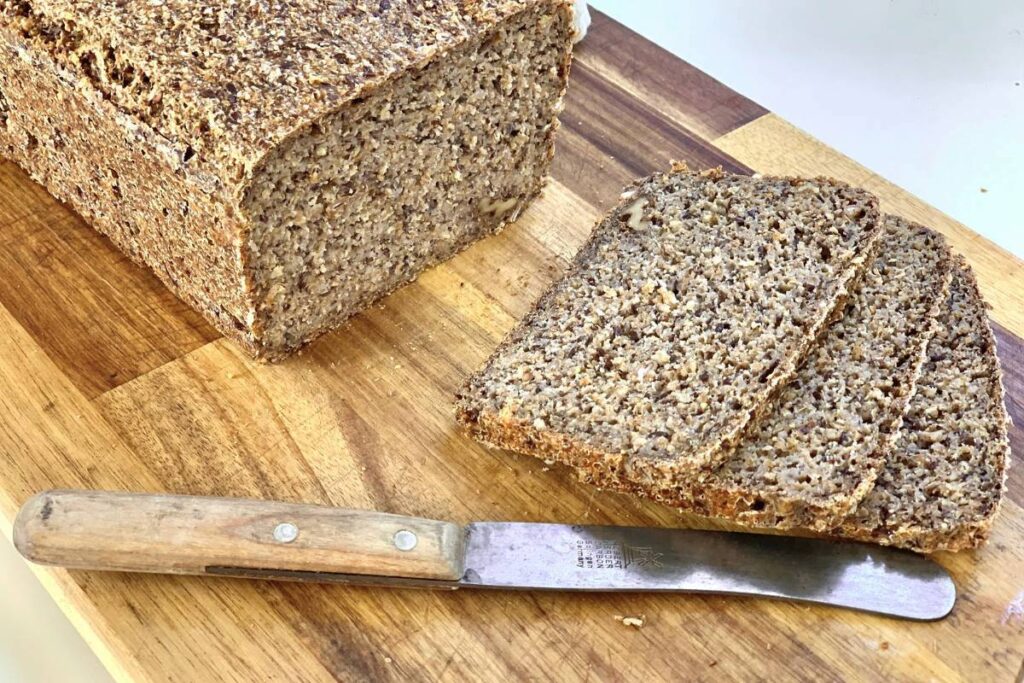
This post contains affiliate links, which means I make a small commission at no extra cost to you. You can read my full disclosure.
What are the ingredients:
These are the ingredients for the basic recipe:
- Whole wheat flour: I prefer organic whole wheat flour and usually grind my own flour
- Sourdough starter: If you don’t already have one, you can check out this super easy way to make a sourdough starter
- Water: I am never sure if this is actually an ingredient or not …
- Salt: Simple sea salt is what I use all the time
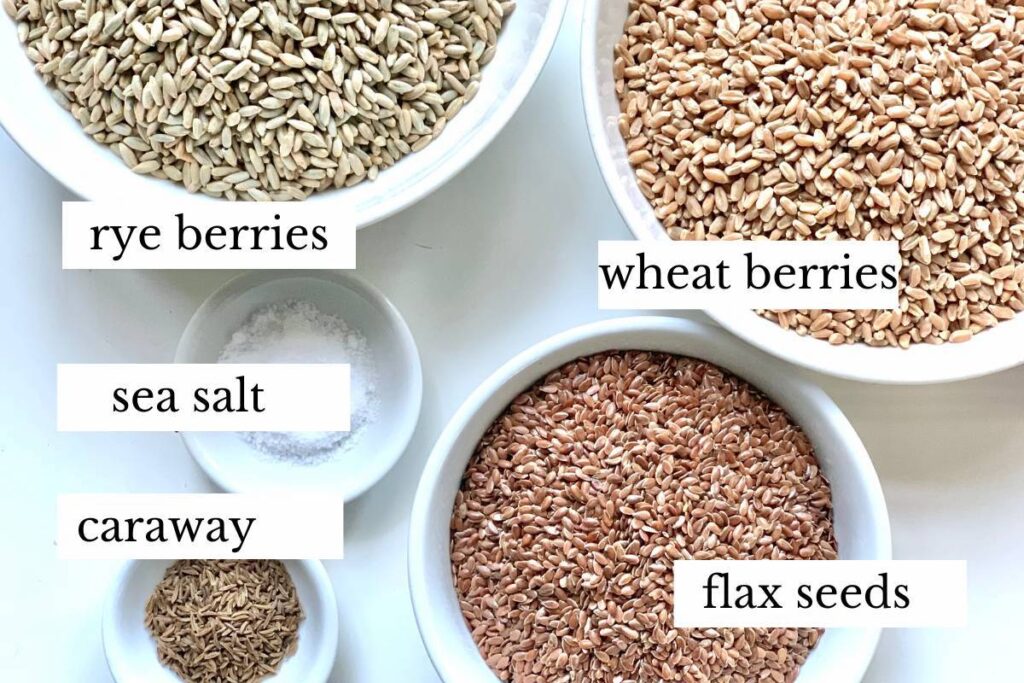
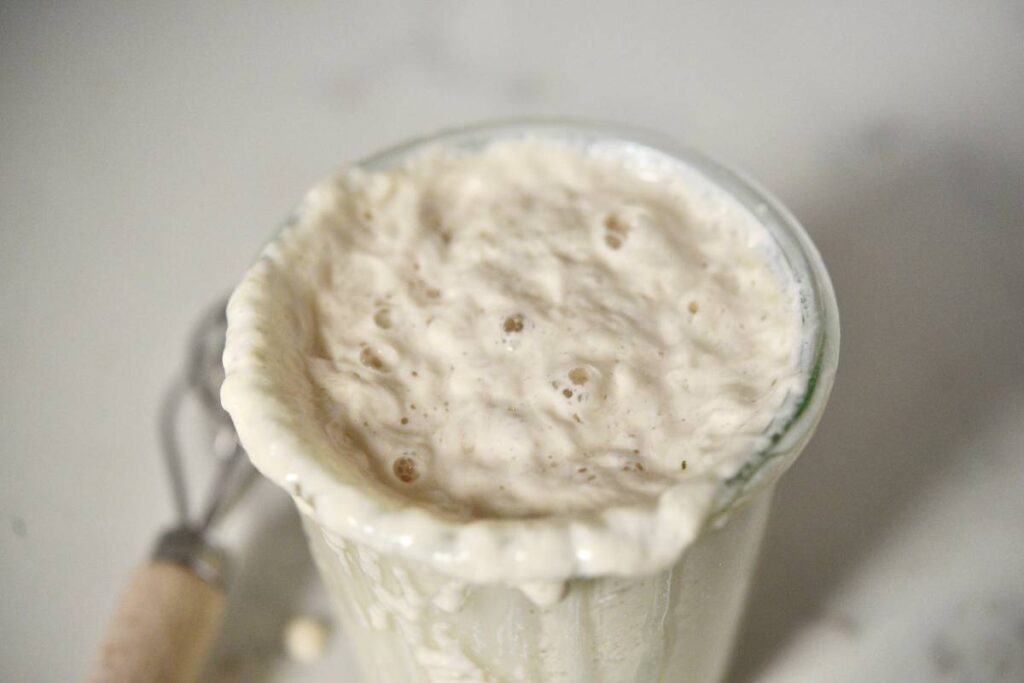
Useful tools and equipment
You don’t need much but for the best results, I recommend having:
- Grain mill: If you are serious about baking your own whole wheat bread, you might want to invest in a high-quality grain mill. You can read more about the grain mills that I use and recommend. Then you can easily make your own fresh whole grain flours. And it’s even stone-milled flour!
- Large bowl: I love being able to mix the dough without having to worry about it spilling over. Even though bakeries use stainless steel for their sourdough bread doughs, I like my big enamel mixing bowl.
- Loaf pan: It is much easier to bake your loaf of bread in a loaf pan than to shape and form a round loaf. On top of that, I prefer having bread with a rectangular shape. That way, all the slices are pretty much the same size. My favorite one is a 9.5″ x 5.5″ glass dish.
I have an entire blog post about my favorite baking tools.
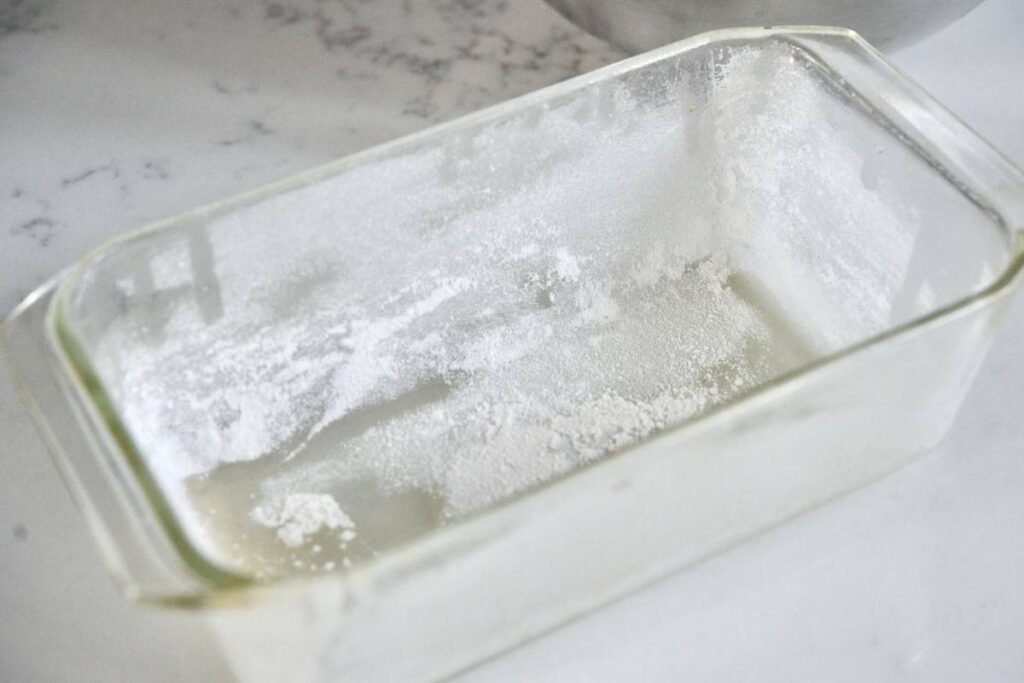
Substitutions and variations
This is the fun part – at least for me and everything you can do with this whole wheat sourdough bread recipe:
- Different flours: While my recipe says whole grain, you can make easily make white bread with white flour. You can also make a 50:50 bread with equal parts white and whole-grain flour or any other type of flour. It’s also fun to use heritage wheat varieties such as Red Fife, Sonora, or others (here’s a list of more heritage wheat varieties). Rye flour works particularly well in sourdough bread recipes. Or use any ratio you like. You can use all-purpose flour or bread flour. If you’re not ready to invest in a grain mill, I recommend you check out King Arthur flour.
- Other grains: These days, I actually barely use wheat. I love ancient grains such as spelt, einkorn, kamut, and rye. However, I have also successfully added ingredients such as millet, quinoa, or amaranth.
- Nuts and seeds: For a hearty healthy bread, I often add flax seeds to this bread. Depending on my mood and the season, I might add pumpkin seeds, sunflower seeds, walnuts, or hazelnuts to it as well. If you are using a lot of rye flour, you might like to add some caraway seeds to the dough as well.
- Other flavors: Feel free to add additional ingredients such as cardamon or herbs to your bread.
How to serve
While tempting, I recommend waiting a few hours (or overnight) to cut the first slice. That way the bread will be so much easier to cut.
We love eating a fresh slice of bread with some butter (best homemade), jam, cheese, or cold cuts! This is my favorite everyday breakfast.
You can even make a peanut butter and jelly sandwich!
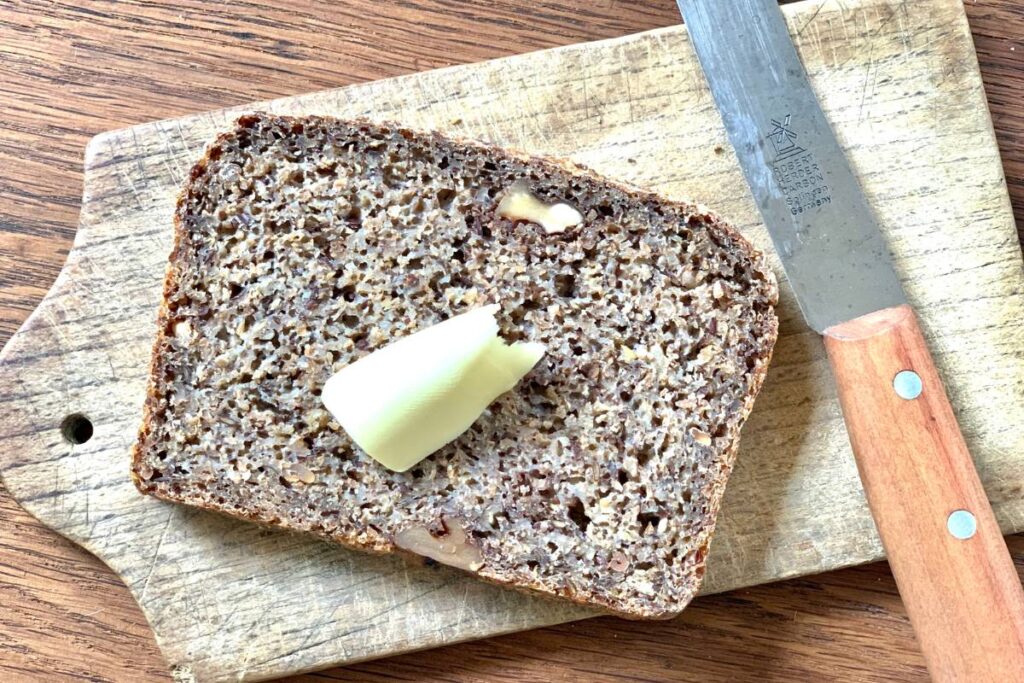
How to Keep Your Sourdough Bread Fresh:
Ideally, you want to store your bread in a linen cloth bag or bread box. That way, it should easily stay fresh for a week.
If you don’t go through it within a week, I recommend storing it in the fridge in an air-tight container or plastic bag. You can also freeze it and thaw it on the counter overnight. Some people, especially smaller households often slice the bread and freeze it then. You can then quickly toast the slices before eating.
I have actually written an entire post on how to keep your sourdough bread fresh.
Sample Schedule
While this schedule depends on so many variables, here’s a rough outline of what has worked the best for me:
- 10 pm: The night before I want to bake, I activate my sourdough starter. This is the essence of my very simple sourdough method.
- 7 am: I quickly grind my grains and mix my dough.
- 1 pm: I transfer the dough to a loaf pan.
- 6 pm: I bake the bread.
Again, this is a very rough schedule. In the summer, the rise time tends to be less, in the winter the dough ferments much slower. Sometimes, I might be busy in the middle of the day and might transfer the bread to the loaf pan a little later in the afternoon. However, you can also do the bulk fermentation overnight and bake your bread the next morning. With just a bit of experience, you will quickly figure out what works best for your schedule.
Note: your first bread may not come out exactly the way you want it to be – don’t be discouraged! Please keep trying, you will get a better feel for it and you will succeed!
New To Sourdough? Check out My Super Simple Sourdough Course!
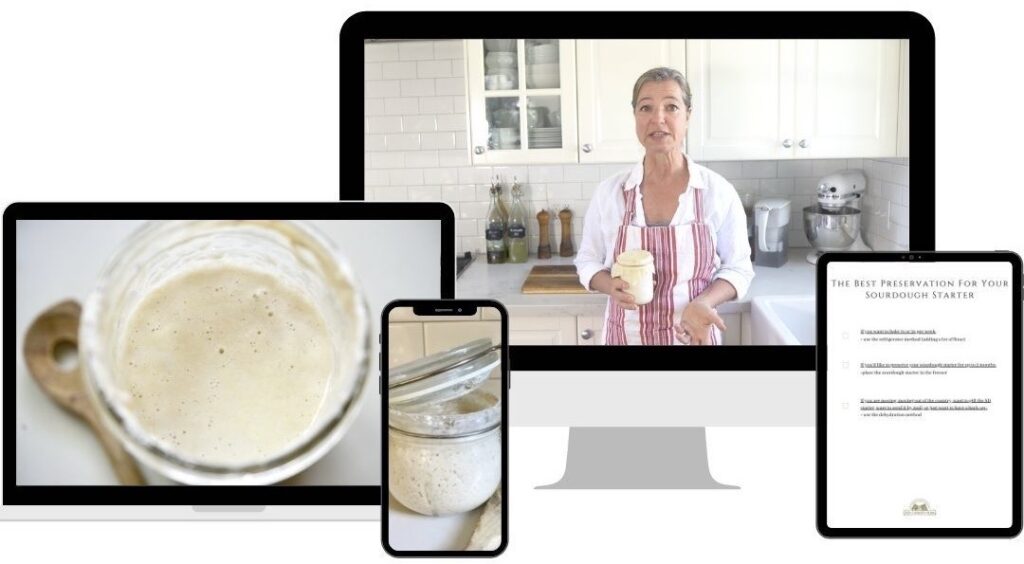
How to make this whole grain sourdough bread
Make the dough:
- Before you begin, be sure you have an active sourdough starter.
- Either use freshly milled flour or use store-bought flour.
- In a large bowl, combine the flour, the sourdough starter, salt, and water. In the winter, it is a good idea to use warm water.
- Mix well. You can do this by hand with a large wooden spoon or Danish dough hook or in your stand mixer.
- Cover the bowl with a beeswax wrap, damp towel, or plastic wrap to keep the top of the dough from drying out.
- Let the dough rest in a warm place for 3-6 hours.
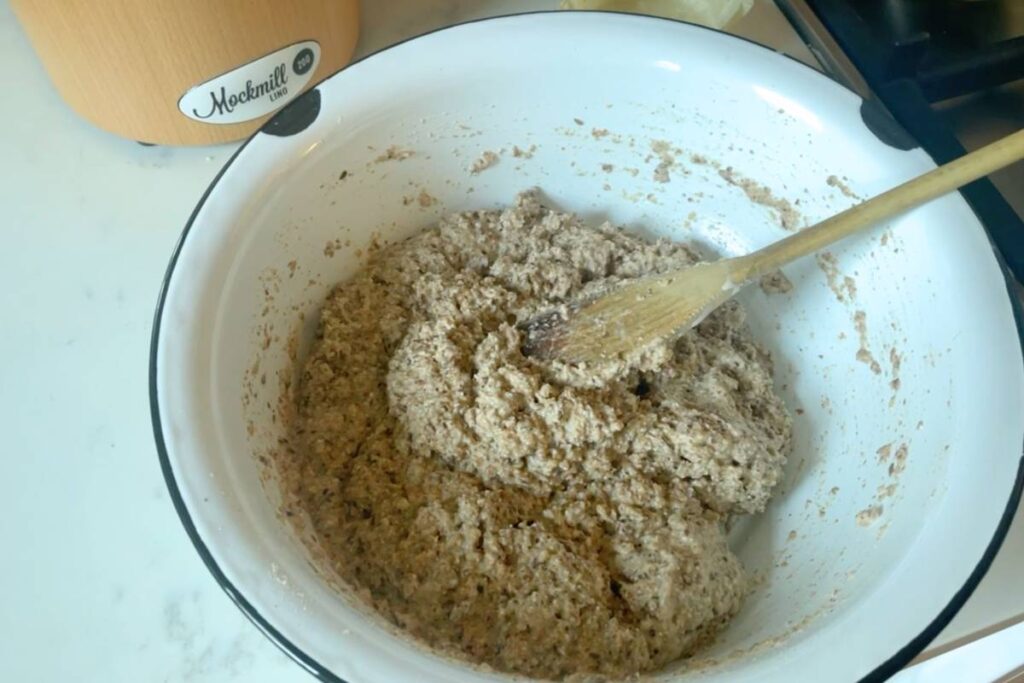
Second fermentation:
- If you like to follow my easy sourdough method and you don’t mind having a whole wheat starter, you can take off about ¼ c of bread dough for your next starter.
- Grease and flour a loaf pan.
- Transfer the dough to the loaf pan and gently smooth out the top of the dough.
- Cover it again and place the covered dough in a warm place but room temperature works just as well.
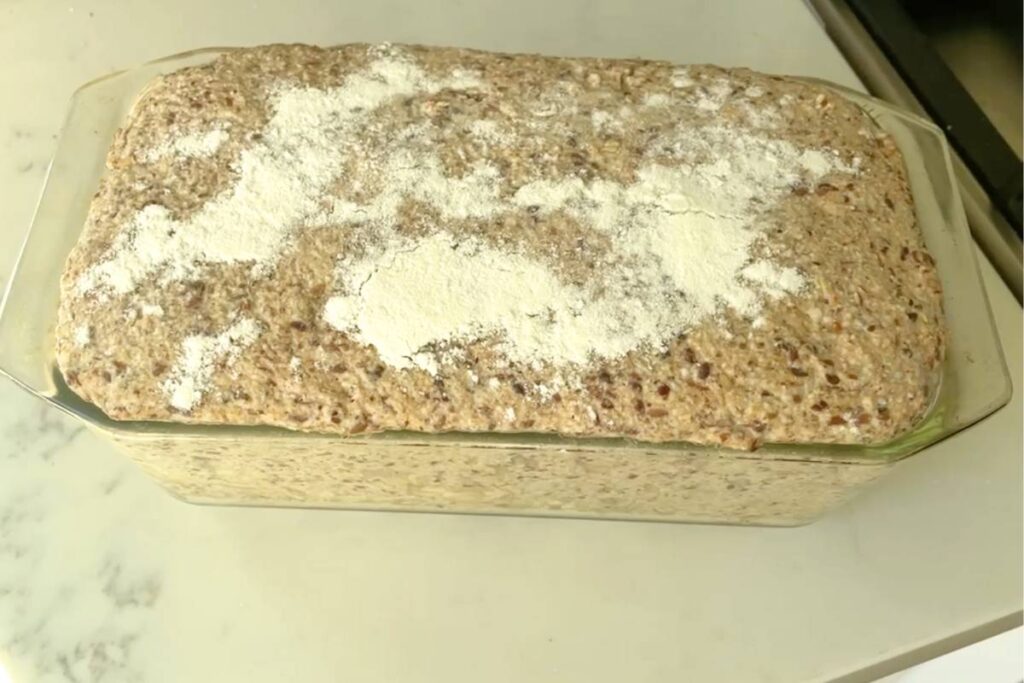
Baking:
- Once the dough has visibly risen, preheat your oven to 350˚F.
- Move the oven rack to the bottom third of your oven.
- Bake your bread until done. The internal, final dough temperature should be around 190˚-200˚F.
- The best method to check if your bread is done is to tap the bottom of the loaf pan. If it sounds hollow, your bread is done. Otherwise, return back to the hot oven for another 10 mins and recheck.
- Let the bread cool down in the bread pan on a wire rack for about 15 mins.
- Carefully invert the loaf pan, remove the bread, and let it cool on a wire rack.
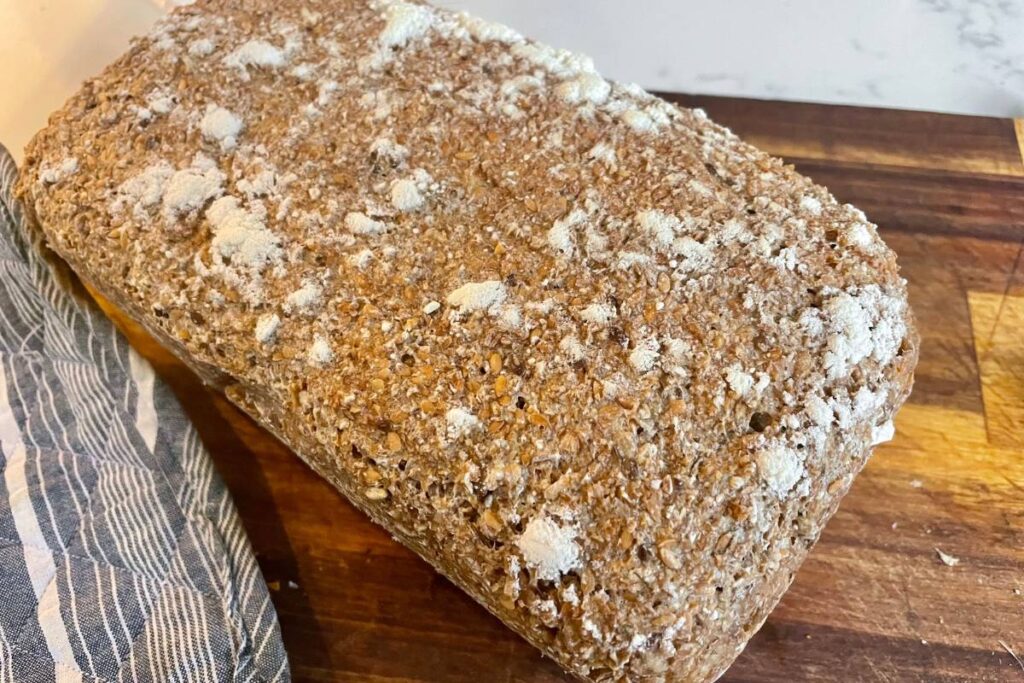
Common questions:
There are a few reasons. Your sourdough starter may still be very young or wasn’t active enough. In that case, you can add a pinch of commercial yeast to your dough. With a bit more practice, you will be able to bake the perfect loaf every time!
Because of the high hydration level of this dough, this whole wheat sourdough bread recipe works best in a bread pan. However, you could let your dough ferment in a bowl or proofing basket lined with parchment paper similar in size to your Dutch oven and very gently transfer it to your Dutch oven for baking.
No, for this super beginner-friendly recipe, you only need to mix the ingredients until well combined.
While you can easily make this a 100% whole wheat sourdough bread, you can add other flours as you like. Adding rye flour makes the bread taste more rustic and sour.
There are a few! Depending on where you source your grains and the quantities you buy, it can be more economical than buying whole-grain flour. More importantly, your flour will be very fresh, and won’t have oxidized or gone rancid.
By using whole grain versus white flour, you get the entire goodness from the whole grain.
Sourdough does take a longer time than yeast. However, that fermentation depletes the starches which means it has a lower glycemic index. It also increases the B vitamins in the bread.
Other bread recipes you might like
No-Knead Artisan Sourdough Bread
Shop this post:
Watch the Youtube video:
Whole Grain Sourdough Bread | Vollkornbrot
Ingredients
- 5 cups whole grains (such as wheat, rye, spelt, einkorn, millet, flax etc)
- 1 ½ – 2 cups active sourdough starter
- 1-2 TBSP salt
- 1 TBSP caraway seeds (optional)
- 3 ½ – 4 cups filtered water
Instructions
- Either use freshly milled flour or use store-bought flour.
- In a large bowl, combine the flour, the sourdough starter, salt, and water.
- Mix well.
- Cover the bowl with a beeswax wrap, damp towel, or plastic wrap to keep the top of the dough from drying out. Let the dough rest in a warm place for 3-6 hours.
- Grease and flour a loaf pan. Transfer the dough to the loaf pan and gently smooth out the top of the dough.
- Place the covered dough in a warm place but room temperature works just as well.
- Once the dough has visibly risen, preheat your oven to 350˚F.
- Bake your bread until done. The internal, final dough temperature should be around 190˚-200˚F.
- Let the bread cool down in the bread pan on a wire rack for about 15 mins. Carefully invert the loaf pan, remove the bread, and let it cool on a wire rack.
Notes
- with this recipe you can pretty much use any grain you want
- you can also replace some of the whole-grain flour with white flour to give it a lighter taste
Nutrition
Pin for later:
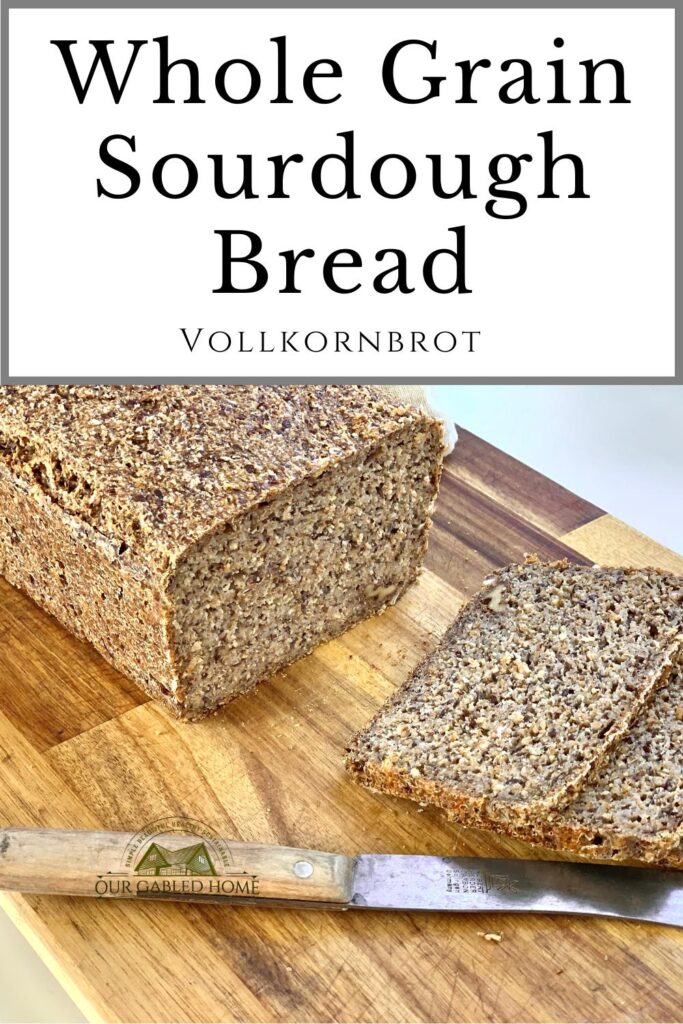
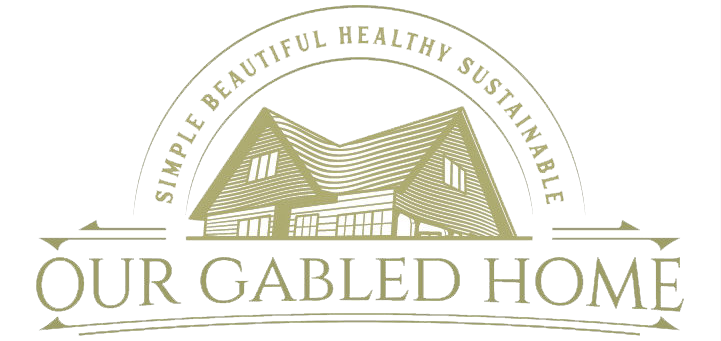

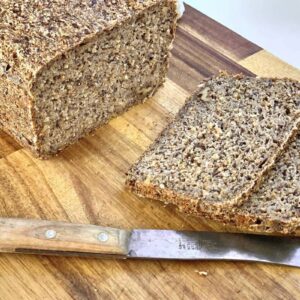
I’m in love with your methods i’ve been baking rye 100% or close. if i don’t do extra steps like pre- ferment and scalds my bread is gummy. Is this recipe at all gummy ? i bake 6X the recipe. You use the words visible risen in the loaf pan what % would that be. i have many sizes pans usually pullman .Thank you 🧑🍳
My bread is either whole wheat or a mixture of various grains and should not be gummy. 100% rye bread will naturally be more dense but shouldn’t be gummy, either. Have you tried lowering the oven temperature and increasing the baking time? Anja
I find it unclear about the flour. Recipe says 5 c whole grains. One comment says that is about 7.5 cups flour where another comment says use 4-5 cups flour. Also do you add the nuts and seeds when you first mix the dough or before adding to the bread pan.
Cup measurements are not very accurate and ultimately it depends on the size of your loaf pan. I add the nuts before adding to the loaf pan ~ Anja
How many loaves does this recipe make? It looks delicious!
it makes medium sized 1 loaf ~ Anja
Can you leave the dough overnight in a warm place instead of the 3 – 6 hours?
If you want to leave it overnight, I’d put it in the fridge, otherwise it gets overproofed ~ Anja
Can I put this bread together, then put in the refrigerator overnight, then bake the next day?
You should, it might be a bit more sour, though ~ Anja
Hi Anja, it’s not clear in the recipe if you grind the flax seeds or leave them whole. Do you grind them?
Good question! I actually grind most of them together with my other grains and then toss a handful of whole flaxseeds into the dough for extra texture ~ Anja
Hi Anya! Thank you so much for this wonderful recipe. I am very excited to make this rustic old world sourdough but the recipe is just a bit unclear to me. I am unsure if I use 5 c of flour or all the flour made from grinding 5 c of grain which would be about 7 1/2 c flour? Thanks so much for your kind response!
Yes, I am using about 5 cups of grains. I will update the recipe accordingly ~ Anja
This looks like such good bread. I will have to make it. Thank you for sharing!
I am so glad you like this recipe! Happy baking ~ Anja
You have so many ads hiding the written content, it is impossible to read the recipe. Moving on to find a better managed site.
I am sorry that you’re finding the ads overwhelming. You can always click “close” or the “x” to make them disappear ~ Anja
I have a quick question…can I make a bigger batch, and store some of the dough in the fridge for the baking within the next few days? I know that refrigeration slows the fermentation…sometimes it would be nice to just reach into the fridge, pull out the dough, and cut out the longer rising phase.
Hi Rae, that is a good question. I would like to say yes but then I have never tried it myself. However, if you’re anything like me, you might just experiment and see what happens. If you do try it out, let me know how it turned out ~ Anja
I want to make your sourdough bread, but I want to bake it in a loaf pan rather than a cast iron skillet. What are the different steps and oven temperature, also how long is baking time?
Thank you, Rosalie
I do bake it in a loaf pan so the times and temperatures in this recipe should work for you. Hope this helps ~ Anja
What is the measurement of whole grain flour equivalent to 5cups of whole grains? I don’t have any equipment to grind my own. Thanks!
A general rule of thumb is that 1 cup of wheat berries is equal to about 1.5 cups of flour when milled ~ Anja
I would love to make a wheat free bread. Can you suggest a mixture as without wheat it’s very difficult to get the texture as a normal bread had
Hi Antonetta, I hope I understand your question correctly: you’re looking for a wheat-free mixture, not necessarily gluten-free. I often use a combination of rye, spelt, and einkorn berries that I grind right before baking. You can also buy rye flour, spelt flour, and einkorn flour. If you’re looking for gluten-free flour, I am not too familiar with them but maybe you find this helpful: https://www.culturesforhealth.com/learn/gf-sourdough/art-of-gluten-free-sourdough-baking/ ~ Anja
I want to make this bread, but I do not have a grinder.
How much store-bought flour should I use?
I think you’ll need less than 2 pounds for this bread as I would use about 4-5 cups of flour. Hope this helps and happy baking ~ Anja
Hi Anga,
I am going to try your bread recipe and adjust amounts to bake in 2 cast iron bread pans. What were the original grains used by your family? Thank you, John
Hi John, I am so glad you like the recipe and that you’re giving it a try!! I am not sure what my great grandparents were using but I know my grandmother was mostly using wheat and in the later years, as it became available, spelt. However, rye works really well in this very flexible recipe! Happy baking!
This looks good! Thank you!
Thank you so much for stopping by!